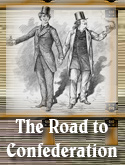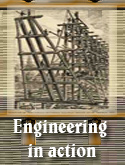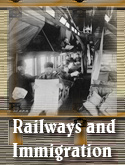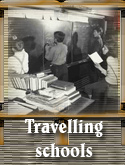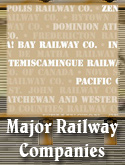Canada’s Major Railway Companies
Champlain and St. Lawrence Rail Road (wooden track)
Dates of operation
Incorporated in 1832, the company began operations in 1836 and was acquired by the Grand Trunk Railway in 1872.
Territory
The province of Québec between the cities of La Prairie and Saint-Jean-sur-Richelieu on Montréal’s South Shore.
Type of service
Freight and passengers
Key figures
John Molson and Peter McGill
Highlights
- Inaugurated on July 21, 1836, the Champlain and St. Lawrence Rail Road was Canada’s first railway.
- The tracks were built of horizontal pine blocks overlaid with iron plates. Before the advent of this “high-speed” train (the locomotive could reach almost 50 km/h!), the trip took nearly two days by boat. The train covered the same distance in under two hours.
- The railway’s first locomotive, the Dorchester, was built in England and assembled in Montréal.
Internet link
Grand Trunk Railway of Canada
Dates of operation
1852-1923
Territory
Initially, Grand Trunk connected Québec and Ontario (the cities of Montréal and Toronto). Later, through the acquisition of other companies, the owners were able to extend service all the way to British Columbia.
Type of service
Natural resources (grain from the Prairies) and passengers
Key figures
Sir Francis Hincks and Sir Charles Melville Hays
Highlights
- The Grand Trunk Railway was formed through the merger of several smaller railways, including the Champlain and St. Lawrence Rail Road, which operated Canada’s first railway starting in 1836.
- In 1867, Grand Trunk was considered to be the world’s largest railway network and the architect of such major engineering projects as the Victoria Bridge and St. Clair Tunnel.
- Grand Trunk Pacific’s trans-Canada railway was completed in 1914.
- The company’s head office was in London, England.
Internet link
Intercolonial Railway
Dates of operation
1872-1918
Territory
The Intercolonial Railway was built to connect the Maritime provinces of New Brunswick and Nova Scotia with the rest of Canada (Ontario and Québec).
Type of service
Passengers and freight
Key figure
Sir Sandford Fleming
Highlights
- Leading up to Confederation, politicians made a commitment to connect future Canadian provinces by rail. Construction of the railway was key to the nation’s success!
- Sandford Fleming, the project’s chief engineer, was responsible for proposing the routes.
- Fleming insisted that all Intercolonial bridges be built of iron.
Internet link
Canadian Northern Railway
Dates of operation
1899-1918
Territory
The company began with routes in Manitoba as far north as Hudson Bay. Canadian Northern went on to serve the entire country.
Type of service
Canadian Northern transported immigrants on their way to settle northern Manitoba as far as Hudson Bay. The company later offered passenger services across Canada.
Key figures
Sir William Mackenzie and Sir Donald Mann
Highlights
- The railway’s last spike was driven in Port Arthur on January 23, 1915.
- Canadian Northern constructed the country’s third trans-Canada railway.
- The company built the world’s first railway tunnel wired with electricity under Mount Royal in Montréal, Québec.
- When the First World War broke out, immigration dropped sharply and the company lost much of its business transporting colonists, many of whom returned to Europe to fight in the war.
- Canadian Northern was one of the companies merged to form Canadian National Railways, now known as CN.
Internet link
Canadian Pacific Railway
Dates of operation
1881-present
Territory
All of Canada from east to west.
Type of service
Currently: freight
Key figures
Sir John A. Macdonald and William Cornelius Van Horne
Highlights
- Canadian Pacific was obligated to complete its trans-Canada route within 10 years, but achieved the feat in just half that time.
- There is a famous photograph of the last spike being driven on November 7, 1885.
- Company President, W.C. Van Horne, suggested that the federal government create national parks along the railway’s route through Alberta and British Columbia to develop tourism in the area.
- Canadian Pacific also operated an airline, CP Air, as well as hotels, passenger liners, mines, experimental farms and telecommunications companies.
Internet link
Internet link
Canadian National Railways, now known as CN
Dates of operation
1923-present
Territory
All of Canada
Type of service
Currently: freight
Key figures
Sir Henry Worth Thornton and Paul Tellier
Highlights
- CN was created through the merger of several railway companies in financial difficulty, including Grand Trunk Railway, Grand Trunk Pacific, Intercolonial and Canadian Northern Railway.
- Canadian National introduced radio broadcasts in its passenger trains, which led to what eventually became the Canadian Broadcasting Corporation.
- The company founded Trans-Canada Air Lines, which became Air Canada.
- Canadian National Railways built the famous CN Tower in Toronto.
Internet link









